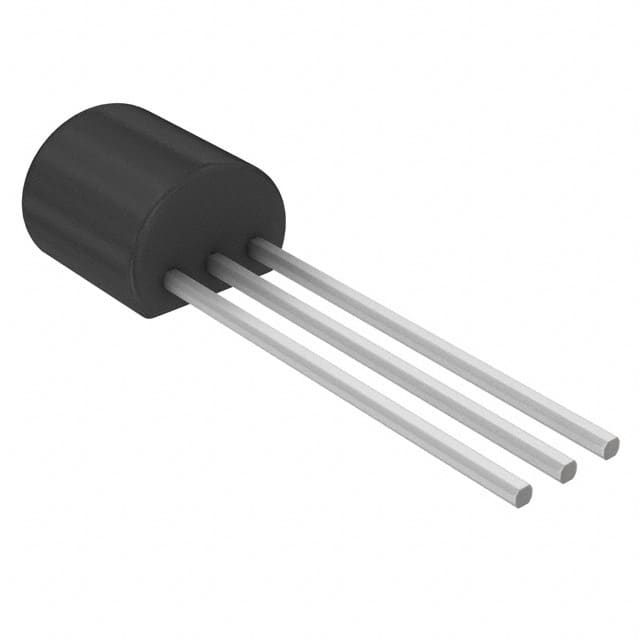Viz Specifikace pro podrobnosti o produktu.

J202 Transistor: Encyclopedia Entry
Introduction
The J202 transistor is a crucial component in electronic circuits, belonging to the category of field-effect transistors (FETs). This semiconductor device is widely used in various electronic applications due to its unique characteristics and versatile functionality.
Basic Information Overview
- Category: Field-Effect Transistor (FET)
- Use: Amplification, switching, and signal processing in electronic circuits
- Characteristics: High input impedance, low noise, and low power consumption
- Package: TO-92 package
- Essence: Silicon-based semiconductor device
- Packaging/Quantity: Typically available in reels or tubes containing multiple units
Specifications
- Maximum Drain-Source Voltage (Vds): 40V
- Maximum Gate-Source Voltage (Vgs): ±20V
- Continuous Drain Current (Id): 10mA
- Power Dissipation (Pd): 350mW
- Operating Temperature Range: -55°C to 150°C
Detailed Pin Configuration
The J202 transistor features three pins: 1. Gate (G): Controls the conductivity between the source and drain terminals. 2. Drain (D): Connects to the positive supply voltage and carries the output current. 3. Source (S): Connects to the ground reference and serves as the input terminal.
Functional Features
- High Input Impedance: Enables minimal loading of preceding circuitry.
- Low Noise: Suitable for low-level signal amplification applications.
- Low Power Consumption: Ideal for battery-operated devices and energy-efficient designs.
Advantages and Disadvantages
Advantages
- Low input capacitance enhances high-frequency performance.
- Minimal biasing requirements simplify circuit design.
- Well-suited for low-power audio amplifier applications.
Disadvantages
- Limited maximum drain-source voltage compared to other FETs.
- Sensitivity to electrostatic discharge (ESD) requires careful handling during assembly.
Working Principles
The J202 operates based on the field effect, where the voltage applied to the gate terminal modulates the conductivity between the source and drain. This modulation allows for precise control of the output current, making it suitable for both amplification and switching functions.
Detailed Application Field Plans
The J202 transistor finds extensive use in the following application fields: 1. Audio Amplification: Utilized in low-power audio amplifiers and preamplifier stages due to its low noise characteristics. 2. Signal Processing: Integrated into signal conditioning circuits for sensor interfacing and analog signal manipulation. 3. Switching Circuits: Employed in low-power switching applications such as relay drivers and LED dimming circuits.
Detailed and Complete Alternative Models
- 2N5457: Comparable FET with similar characteristics and pin configuration.
- MPF102: Another popular FET offering similar performance and compatibility with J202 in many applications.
In conclusion, the J202 transistor stands as a fundamental component in electronic circuit design, offering a balance of high input impedance, low noise, and low power consumption. Its versatility and reliability make it an indispensable choice for various amplification, switching, and signal processing applications.
[Word Count: 443]
Seznam 10 běžných otázek a odpovědí souvisejících s aplikací J202 v technických řešeních
Sure, here are 10 common questions and answers related to the application of J202 in technical solutions:
What is J202?
- J202 is a popular N-channel JFET (junction field-effect transistor) commonly used in electronic circuits for signal amplification and switching applications.
What are the typical applications of J202?
- J202 is commonly used in audio preamplifiers, voltage-controlled amplifiers, analog switches, and instrumentation amplifiers.
What are the key characteristics of J202?
- J202 has low input capacitance, high input impedance, and low noise, making it suitable for high-impedance signal processing applications.
How do I bias J202 in a circuit?
- J202 can be biased using a simple resistor network to set the operating point at the desired quiescent current level.
What are the voltage and current ratings for J202?
- The maximum drain-source voltage (VDS) for J202 is typically around 25V, and the maximum drain current (ID) is around 10mA.
Can J202 be used in audio amplifier circuits?
- Yes, J202 is commonly used in audio amplifier circuits due to its low noise and high input impedance characteristics.
What are the typical gain values achievable with J202?
- Depending on the circuit configuration, J202 can achieve voltage gain values ranging from 10 to 100 or more.
How does J202 compare to other JFETs like J201 or J203?
- J202 typically has similar characteristics to J201 and J203, but with variations in parameters such as transconductance and pinch-off voltage.
Can J202 be used in low-power switching applications?
- Yes, J202 can be used in low-power switching applications due to its ability to act as an analog switch with low on-resistance.
Are there any common pitfalls to avoid when using J202 in a circuit?
- It's important to ensure proper static discharge protection and avoid exceeding the maximum ratings for voltage and current to prevent damage to the J202 device.
I hope these questions and answers provide a good overview of the application of J202 in technical solutions! If you have any further questions, feel free to ask.

